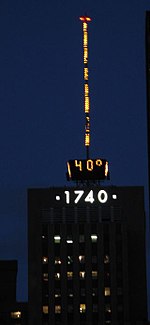220 West 57th Street

220 West 57th Street (formerly known as the Society House of the American Society of Civil Engineers or the ASCE Society House) is a building on 57th Street in Midtown Manhattan in New York City. It was designed by Cyrus L. W. Eidlitz in the French Renaissance Revival style, with an annex built to designs by Eidlitz and Andrew C. McKenzie. The building served as the headquarters of the American Society of Civil Engineers (ASCE) from 1897 to 1917. 220 West 57th Street is four stories tall, with a basement, though the top two stories only cover a portion of the site. The facade is made largely of white glazed brick with ornamentation made of elaborately carved Indiana Limestone. The second story contains an elliptical ogee arch with a tripartite window, while the top of the building has a cornice with modillions. The interior originally contained a lounge, reading room, auditorium, offices, and stacks for the ASCE's library. When the ASCE moved out, the interior was converted to commercial space, and escalators and elevators were installed. The building was proposed in early 1895 to replace the ASCE's previous overcrowded headquarters, and Eidlitz was selected as the architect as a result of an architectural design competition. The building opened on November 24, 1897, and an annex was built between 1905 and 1906 to accommodate the ASCE's increased attendance. After moving out, the ASCE continued to own 220 West 57th Street until 1966, leasing the space to automotive showrooms and various office tenants. The building also housed a Schrafft's restaurant between 1928 and the 1970s, and Lee's Art Shop between 1975 and 2016. The New York City Landmarks Preservation Commission designated the building as a city landmark in 2008.
Excerpt from the Wikipedia article 220 West 57th Street (License: CC BY-SA 3.0, Authors, Images).220 West 57th Street
West 57th Street, New York Manhattan
Geographical coordinates (GPS) Address External links Nearby Places Show on map
Geographical coordinates (GPS)
| Latitude | Longitude |
|---|---|
| N 40.7657 ° | E -73.9812 ° |
Address
West 57th Street 220
10019 New York, Manhattan
New York, United States
Open on Google Maps







